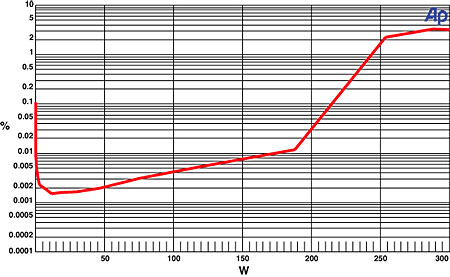Yamaha RX-Z11 A/V Receiver HT Labs Measures
Five channels driven continuously into 8-ohm loads:
0.1 percent distortion at 153.2 watts
1 percent distortion at 183.1 watts
Seven channels driven continuously into 8-ohm loads:
0.1 percent distortion at 139.4 watts
1 percent distortion at 160.4 watts
Analog frequency response in Pure Direct mode:
+0.07 dB at 10 Hz; +0.01 dB at 20 Hz
–0.01 dB at 20 kHz; –2.75 dB at 50 kHz
Analog frequency response with stereo signal processing:
–1.48 dB at 10 Hz; –0.44 dB at 20 Hz
–0.02 dB at 20 kHz; –25.17 dB at 50 kHz

This graph shows that the RX-Z11’s left channel, from CD input to speaker output with two channels driving 8-ohm loads, reaches 0.1 percent distortion at 214.8 watts and 1 percent distortion at 243.6 watts. Into 4 ohms, the amplifier reaches 0.1 percent distortion at 311.3 watts and 1 percent distortion at 387.4 watts.
Response from the multichannel input to the speaker output measures +0.07 decibels at 10 hertz, +0.01 dB at 20 Hz, –0.02 dB at 20 kilohertz, and –2.77 dB at 50 kHz. THD+N from the CD input to the speaker output was less than 0.007 percent at 1 kHz when driving 2.83 volts into an 8-ohm load. Crosstalk at 1 kHz driving 2.83 volts into an 8-ohm load was –102.66 dB left to right and –98.89 dB right to left. The signal-to-noise ratio with 2.83 volts driving an 8-ohm load from 10 Hz to 24 kHz with “A” weighting was –106.95 dBrA.
From the Dolby Digital input to the loudspeaker output, the left channel measures –0.06 dB at 20 Hz and –0.09 dB at 20 kHz. The center channel measures –0.06 dB at 20 Hz and –0.09 dB at 20 kHz, and the left surround channel measures –0.06 dB at 20 Hz and –0.10 dB at 20 kHz. From the Dolby Digital input to the line-level output, the LFE channel is +0.12 dB at 20 Hz when referenced to the level at 40 Hz and reaches the upper 3-dB down point at 96 Hz and the upper 6-dB down point at 116 Hz.—MJP
- Log in or register to post comments






























































